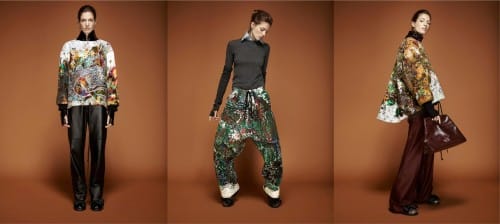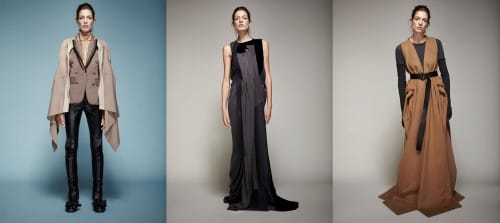Jessica Trosman is a designer who does not need much introduction due to her national and international experience. Her textile innovation and highly complex patterns place her among the most important designers of the fashion world. She is an Argentinian designer who competes in capitals like New York, Paris and Tokyo thanks to the high standard of her art. Her experimentation has won her several awards that allow her to sell in the United States, Europe, Japan and the Middle East. She was even selected as one of the most influential designers in the well known catalogue by editorial Taschen, Fashion Now 2.

Jessica Trosman. PH: Luciana Val & Franco Musso.
The Villa Crespo neighborhood of Buenos Aires is an area full of factories, that retains the look and feel of the 1970s. The combination between the hood and Trosman's store generates an interesting contrast. JT By Jessica Trosman is awakening curiosities between garages and the Atlanta's stadium on Humbolt Street, where she runs a textile laboratory, production workshop and store.
Once inside, the work of artist Ekkehard Altenburger captures visitors' attention almost immediately. The inevitable smell of coffee and freshly baked pastries wafts in from the restaurant in the next room. Yeite, the first restaurant of Pamela Villar, is one of the most renowned pastry shops associated with the fashion sector. The energy of the place is balanced by a set of hanging plants and the natural light that filters through the ceiling and bounces off the white walls. The recomposition of space was delivered by Net study, owned by designer Alexander Sticotti.
It is impossible to avoid seeing Jessica from the glass box behind the wide, antique wooden display. Meeting with her team, she beckons us to give her another minute before the interview. We nod and go through the racks to enjoy each hung creation. Sorted by color, each piece is a pleasure to behold, with parts entering, leaving, shriveling, docking,projecting into space, and changing color. All this is accomplished with effortless calculation. Trosman approaches and asks us to take a seat at a table in Yeite.
Why did you come back to the neighborhood?
Somehow I never left. This deposit was my dad's. Here we started with Martin (Churba) our project 'Trosman Churba' and before that started doing product development for local brands (Ona Saez and Kosiuko). It was always behind closed doors working as a workshop, but I never doubted it would work out as a store. This neighborhood is very quiet and is good because I feel cared for.
In fact, I think the fashion centers such as Palermo and malls are oversized and out of the fashion circuit. It's interesting to be discovered by other public. Our customers have a special taste for clothes and if he or she comes down here, it is to buy. So I decided to open the doors of the factory and merge all in a common space, from development to sales.
What were your first approaches to aesthetics?
As a child my mother took me shopping. I always decided what my family would wear. From age twelve, I knew I was going to be a fashion designer, I always liked to think outside the box when it came to clothes. I remember an enterito that had a zipper and I liked to imagine what all the other possibilities could be for that zipper. I was always interested in doing things the way they shouldn't be or at least in a new way. That gave me an imprint for my label. I don't like flat clothing, I like 3-D clothes, with volumes. I love to do tricks and make it look difficult to understand. I want to deliver others the need to spin, investigate and discover. My clothes have to be a challenge for my intellect and for others. Otherwise it would be boring to come here and do the same clothes everyday.
What was your first experiences in design?
I studied Fashion Design at the University of Miami where I learned to sew and pattern, but I did not finish because I came back to Buenos Aires following the father of my first child. To please my family I studied English Translation at the University of El Salvador. I remember fondly the days of university study because the atmosphere was very pleasant and familiar. It is very important to study anything because it gives general culture and always opens roads. However, I served two months and returned to the clothes immediately. (Laughs)
How do other disciplines influence your creative process?
I think everything visual helps me and inspires me. Besides contemporary art and cuisine, I am a fan of plants and architecture. All the time I'm looking for different proportions. I think the contribution of other disciplines helps me to perfume my designs. All the time I'm going to museums and watching people on the street to let my imagination go.

JT by JT. MUTUARETROMORFA AW15. Experimental printing co-created with Argentinian artist Vicente Grondona.
What do you think about the influence of internet on design process?
I think new designers are contaminated with what they see on the internet. To be relevant in fashion you have to come up with something genuine that nobody has ever seen before. At the same time, new media is something global that is regulating aesthetic everywhere. It’s really hard to ask new designers to come up with a cutting edge creation after school because most of the time they don’t count on the financial support they will need to create and also the lack of commercial channels to show their creations. And they have to appeal to social media again. It’s an odd dilemma.
What would be your recommendation for this problem?
In my day it was harder because I had to travel to get true editorial material. Now that’s solved with internet. It’s so much easier to find what’s going on on the other side of the planet and somehow fashion still commands big fashion capitals which are using new satellite fashion trends to create brand new trends on their own.
I suggest that new fashion designers see what’s going on around. But to create something special you need to stop at some point and put hands to work. I know for sure there’s so much new fashion designers want to tell and they have the creativity to do it. I also recommend they keep on giving chances to their own aesthetics and don't become commercial just for money or you will be betraying your vision.
What is your creative process to come up with a collection?
In the beginning, I go with a concept to production workshop and start making clothes. After studying the constructive resource, I take children out of those main garments. The development of the line responds to a commercial grid that we must continue but the results sometimes are more simple or more elaborate garments. During the process, new subtopics appear that were not there in the beginning. That is interesting. So I use them too and put it all together.
What do you keep from your days working with Martin Churba?
Above all, I keep a great friendship. We love each other very much. It was so intense, everything that happened in 'Trosman Churba'. I also keep the importance of teamwork. It is essential to enrich the creative process; and of course the experimentation in textile I learned with him and continue to develop in my imprint. I remember that we were just two guys who started with a thousand dollars each who took full advantage of any opportunity that presented itself. We were just a couple of brats.
How many retailers do you have?
We have thirty approximately. We sell in the USA, Europe, Asia and the Middle East. The truth is we are very happy to participate in places like Korea, where the public is very demanding and knowledgeable about fashion. I always like to go abroad to nourish and compete with renowned designers. We are now going to sell AW16 in Paris and return to present it in Argentina under the 'Buenos Aires Designers' fashion show. Some of our retailers are in London, Paris, Los Angeles, New York, Tokyo, Saudi Arabia, Copenhagen, Seoul, Kuwait, Dubai, Hong Kong, Sydney, Austria, China and Moscow.
What do you feel is your contribution to Argentine design DNA?
I remember when I started to go to Paris and they told me that they didn't understand my designs but that they were cool with that. I think my contribution comes from the construction that defies common understanding of fashion—volumes projecting into space without apparent reason. I feel more useful and capable doing complex patterns. It gives something interesting to customers, and design students to watch and learn.

JT by JT. MUTUARETROMORFA AW15
What are you showing for next season?
I like working with Japanese textile processes. For next winter I will be showing new reconstructions of antique denim clothing. For this new collection I have been working with the denim brand LEE. We’ll be offering a line LEE by Jessica Trosman. I used their products which I intertwined with prints and reconstruction. Also, men's items will be available.
What else would you like to explore with JT?
There are always new ideas. Sometimes we think about doing objects for decoration. But unfortunately we do not have the time to deviate from what we do. It is best to focus and do what we do well. Another time when I have time and desire to do something else I will. For now, this is it.
The work of Jessica Trosman will remain strong for years to come because of her inexhaustible creative energy. Her design aesthetics have always given new business opportunities around the world. Each of her projects have been a reference channel for the local market as an inspiring example of how true innovation can compete with the main houses in big fashion fields.
